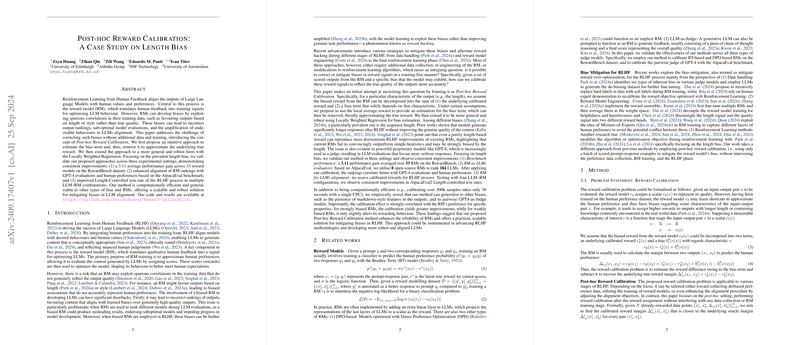Post-hoc Reward Calibration: Addressing Length Bias in Reinforcement Learning from Human Feedback
The paper "Post-hoc Reward Calibration: A Case Study on Length Bias" explores the intricacies of mitigating biases present in Reward Models (RMs) employed in Reinforcement Learning from Human Feedback (RLHF). As LLMs increasingly align with human preferences, RMs are instrumental in translating qualitative feedback into quantitative training signals. However, RMs frequently develop biases, such as favoring longer outputs, which can result in misleading model performance evaluations and suboptimal LLM behavior.
Key Contributions
- Bias Identification and Correction: The paper introduces a novel methodology termed Post-hoc Reward Calibration that aims to correct RM biases without necessitating additional data or retraining the models. The primary focus is on length bias, which has been shown to impact RM accuracy significantly.
- Methodology:
- Decomposition and Estimation: The approach decomposes rewards into a true reward and a bias component. A Locally Weighted Regression (LWR) method estimates the bias, enabling the removal of biases from output evaluations.
- Implementation Across Multiple Settings: The effectiveness of the approach is validated through three distinct experimental settings: RM benchmark performance on the RewardBench dataset, RM evaluations as LLM judges, and RM use in LLM alignment.
- Empirical Results:
- Demonstrated an average performance improvement of 3.11 across 33 RMs on RewardBench.
- Enhanced alignment with GPT-4 and human evaluations on the AlpacaEval benchmark.
- Significant reductions in length bias and performance enhancements in LLM alignment tasks, as measured by the Length-Controlled win rate.
Implications
The practical implications of this research extend to improving bias correction processes within RLHF, enhancing both the reliability and robustness of LLMs. The calibration technique developed is computationally efficient, adaptable to various biases, and scalable across different RM types and configurations. It promises substantial strides in the quality of LLM outputs by mitigating reward hacking phenomena and ensuring a more accurate reflection of true task performance.
Theoretical Insights
Theoretically, the paper offers a framework for understanding and addressing biases in reward signals, extending beyond length bias to other potential sources of bias such as stylistic preferences. By utilizing LWR, the method adapts to local data variations, thereby promising generality in addressing biases present in the diverse characteristics of training data.
Future Directions
The paper paves the way for further explorations in calibrating RMs against a broader scope of biases and characteristics. Future developments may involve refining calibration methods to enhance their adaptability and efficacy across varying datasets and model types, ultimately contributing to more nuanced and bias-resistant AI systems.
Overall, the research presents a robust and scalable solution for one of the pivotal challenges in aligning LLMs with human feedback, marking a significant advance in the ongoing efforts to optimize AI-human interactions.
